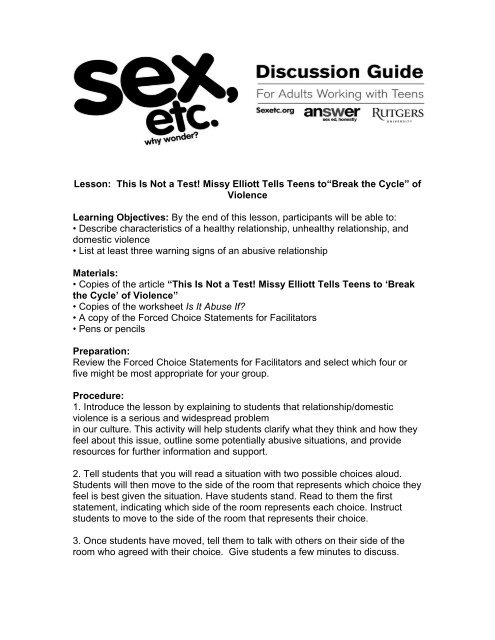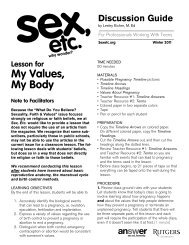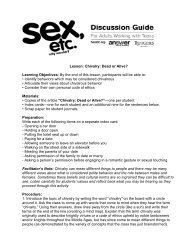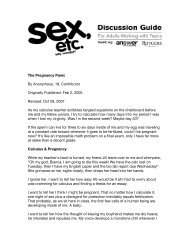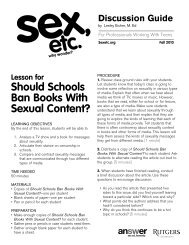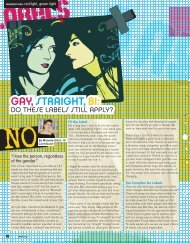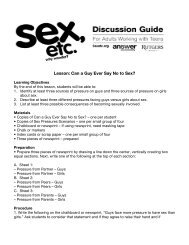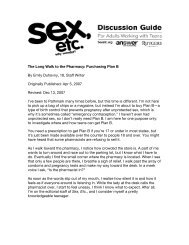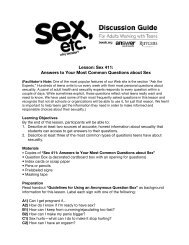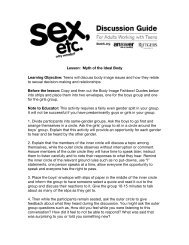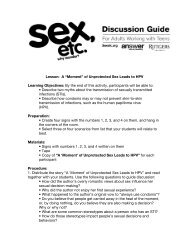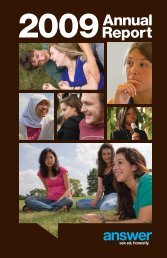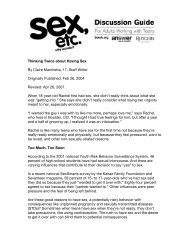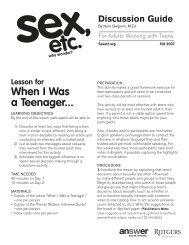Lesson: This Is Not a Test! Missy Elliott Tells Teens to ... - Answer
Lesson: This Is Not a Test! Missy Elliott Tells Teens to ... - Answer
Lesson: This Is Not a Test! Missy Elliott Tells Teens to ... - Answer
You also want an ePaper? Increase the reach of your titles
YUMPU automatically turns print PDFs into web optimized ePapers that Google loves.
<strong>Lesson</strong>: <strong>This</strong> <strong>Is</strong> <strong>Not</strong> a <strong>Test</strong>! <strong>Missy</strong> <strong>Elliott</strong> <strong>Tells</strong> <strong>Teens</strong> <strong>to</strong>“Break the Cycle” of<br />
Violence<br />
Learning Objectives: By the end of this lesson, participants will be able <strong>to</strong>:<br />
• Describe characteristics of a healthy relationship, unhealthy relationship, and<br />
domestic violence<br />
• List at least three warning signs of an abusive relationship<br />
Materials:<br />
• Copies of the article “<strong>This</strong> <strong>Is</strong> <strong>Not</strong> a <strong>Test</strong>! <strong>Missy</strong> <strong>Elliott</strong> <strong>Tells</strong> <strong>Teens</strong> <strong>to</strong> ‘Break<br />
the Cycle’ of Violence”<br />
• Copies of the worksheet <strong>Is</strong> It Abuse If?<br />
• A copy of the Forced Choice Statements for Facilita<strong>to</strong>rs<br />
• Pens or pencils<br />
Preparation:<br />
Review the Forced Choice Statements for Facilita<strong>to</strong>rs and select which four or<br />
five might be most appropriate for your group.<br />
Procedure:<br />
1. Introduce the lesson by explaining <strong>to</strong> students that relationship/domestic<br />
violence is a serious and widespread problem<br />
in our culture. <strong>This</strong> activity will help students clarify what they think and how they<br />
feel about this issue, outline some potentially abusive situations, and provide<br />
resources for further information and support.<br />
2. Tell students that you will read a situation with two possible choices aloud.<br />
Students will then move <strong>to</strong> the side of the room that represents which choice they<br />
feel is best given the situation. Have students stand. Read <strong>to</strong> them the first<br />
statement, indicating which side of the room represents each choice. Instruct<br />
students <strong>to</strong> move <strong>to</strong> the side of the room that represents their choice.<br />
3. Once students have moved, tell them <strong>to</strong> talk with others on their side of the<br />
room who agreed with their choice. Give students a few minutes <strong>to</strong> discuss.
4. Start with the side with fewer students and ask for volunteers <strong>to</strong> share why<br />
they felt that decision was best.<br />
(Facilita<strong>to</strong>r’s <strong>Not</strong>e: You might need <strong>to</strong> remind students about class ground rules<br />
<strong>to</strong> insure that only one person speaks at a time and <strong>to</strong> listen and respect others.)<br />
Next, ask for volunteers <strong>to</strong> share their opinion from the other side. Remind<br />
students that they can switch sides if they hear a compelling argument and<br />
change their mind. The facilita<strong>to</strong>r should ask any appropriate clarifying or “devil’s<br />
advocate” questions. For example, with the question: If your friend confided that<br />
his or her partner was being physically abusive, would you:<br />
• try <strong>to</strong> help your friend, or<br />
• stay out of it<br />
Ask students that would try <strong>to</strong> help, what is it that they would do specifically <strong>to</strong><br />
help? Ask students who would stay out of it, what possible consequences would<br />
that choice have?<br />
SPRING 2004<br />
For Adults Working with <strong>Teens</strong><br />
5. Read the next statement and follow the same procedure. Spend approximately<br />
15 minutes reading statements, having students move <strong>to</strong> represent their choice,<br />
and discussing their reasons for choosing that side. Then ask students <strong>to</strong> return<br />
<strong>to</strong> their seats.<br />
6. To process the entire activity, ask students the following questions:<br />
• What was helpful about this exercise?<br />
• What did you learn (about others or yourself) that you didn’t know before?<br />
7. Distribute copies of the article “<strong>This</strong> <strong>Is</strong> <strong>Not</strong> a <strong>Test</strong>! <strong>Missy</strong> <strong>Elliott</strong> <strong>Tells</strong> <strong>Teens</strong><br />
<strong>to</strong> ‘Break the Cycle’ of Violence” and read <strong>to</strong>gether with the class. Ask the<br />
following discussion questions related <strong>to</strong> the article:<br />
• What are characteristics of an unhealthy relationship? A healthy relationship?<br />
• Why might teens not tell or get help if they’re in an abusive relationship?<br />
• Where could teens go <strong>to</strong> get help or more information?<br />
8. Divide students in<strong>to</strong> groups of three. Distribute the <strong>Is</strong> It Abuse If? worksheet <strong>to</strong><br />
each student. Instruct groups <strong>to</strong> read each statement and discuss whether they<br />
feel the situation is abusive or not and why. Give them ten minutes <strong>to</strong> complete<br />
this exercise.<br />
9. Gather students’ attention and begin discussing each situation individually.<br />
Ask groups <strong>to</strong> report their opinions about whether the situations are abusive or<br />
not and why.<br />
(Facilita<strong>to</strong>r’s <strong>Not</strong>e: All of the situations could be considered abusive<br />
[emotionally, physically, sexually, etc.] depending on certain fac<strong>to</strong>rs, such as age,<br />
relationship between people, interest in pressing charges, etc. They are<br />
intentionally vague with no clear answer, <strong>to</strong> spur group discussion.)
To close the lesson, ask the small groups <strong>to</strong> briefly discuss the following<br />
question:<br />
What might help prevent dating violence among teens?<br />
Ask volunteers <strong>to</strong> share their ideas with the entire group. Remind students that<br />
resources for information and support about relationship violence are listed in the<br />
article.<br />
The Discussion Guide was created by Nora Gelperin, M.Ed., direc<strong>to</strong>r of training<br />
and education at <strong>Answer</strong>. For additional lessons, go <strong>to</strong><br />
http://answer.rutgers.edu/page/lesson_plans.<br />
Copyright © <strong>Answer</strong>, Rutgers University. All Rights Reserved.
“<strong>Is</strong> It Abuse If…?” (50 minutes)<br />
Learning Objective: By the end of this activity, participants will be able <strong>to</strong>:<br />
• Clarify their own values about what is and what is not abuse in a relationship<br />
1. Say <strong>to</strong> the participants, Building on the idea that we don’t always think of certain<br />
behaviors when we hear abuse, we often also disagree on what is or is not abusive. Let<br />
participants know that you are going <strong>to</strong> hand out a sheet <strong>to</strong> them titled, “<strong>Is</strong> it Abuse If…?”<br />
Ask them <strong>to</strong> fill the sheet out individually (providing pens <strong>to</strong> those in need). Highlight the<br />
fact that they can only choose “Yes” or “No” – there is no “unsure,” so they must commit<br />
<strong>to</strong> an answer.<br />
2. Once they have finished, break the group in<strong>to</strong> smaller groups of no fewer than 4 each.<br />
Let them know that their task is <strong>to</strong> discuss the examples, and in the end, all agree on<br />
what within the examples constitutes abuse and what does not.<br />
3. Once the groups have been discussing for about 15 minutes, open the discussion up<br />
in<strong>to</strong> the larger group, keeping the small groups where they are. Ask the following<br />
questions:<br />
• What was it like <strong>to</strong> do the activity? What was easy or hard about it?<br />
• Did your group come <strong>to</strong> consensus on ALL the examples? Why/why not?<br />
• Which of the examples did your group get stuck on? (Discuss this example with the<br />
larger group, taking other examples as requested).<br />
(FACILITATOR NOTE: It is also important <strong>to</strong> try <strong>to</strong> stir up the discussion with<br />
participants, modeling this so that they will do the same with their students. For<br />
example, on the statement pertaining <strong>to</strong> a boyfriend slapping his girlfriend, you can ask,<br />
“What if the girlfriend was becoming hysterical, and he was trying <strong>to</strong> get her <strong>to</strong> focus –<br />
rather than slapping her in anger?” Be sure that the questions you come up with present<br />
both sides <strong>to</strong> avoid betraying your own opinions on these. Point out <strong>to</strong> the teachers that<br />
they should do the same, highlighting that there are no absolute right or wrongs – it<br />
depends on the circumstances, on the people involved, etc. Let them know that they<br />
should NOT tell students how they would vote on any of these statements.)<br />
4. Take home messages: What one person may determine <strong>to</strong> be abusive in a<br />
relationship may not be the same thing as what another person does. <strong>This</strong> is why<br />
communication, especially about expectations in a relationship, is so important. If a<br />
person feels disrespected, that person needs <strong>to</strong> tell her/his partner, and vice versa.<br />
Alternatively, if there is a behavior that a person really appreciated, s/he needs <strong>to</strong> let<br />
her/his partner know that as well.<br />
5. Explain <strong>to</strong> teachers that this is an excellent activity <strong>to</strong> use in a classroom setting. It is,<br />
however, an activity that needs <strong>to</strong> be facilitated carefully. Provide participants with the<br />
following guidelines for conducting this with students:
• Remind your student of the groundrules.<br />
• Let students know that this activity is about what is on their sheet of paper, not their<br />
own experience. Tell them even before the activity has started that it might be tempting<br />
<strong>to</strong> compare something they’ve read <strong>to</strong> their own relationships, but that this is not the<br />
place in which <strong>to</strong> do so. If you hear that someone is starting <strong>to</strong> talk about something<br />
personal, jump in and remind them of this boundary, asking them <strong>to</strong> hold off if they’re<br />
thinking of recounting a personal s<strong>to</strong>ry or experience.<br />
• If a true disagreement exists, move on <strong>to</strong> another point, highlighting the groundrules,<br />
agreeing <strong>to</strong> disagree.<br />
• When facilitating this activity with your students, play the “devil’s advocate” as I did.<br />
For example, if people feel that the boy who walks his girlfriend <strong>to</strong> school every morning,<br />
picks her up from and walks her <strong>to</strong> each class, and meets her at the end of the day is<br />
being abusive, ask “<strong>Is</strong> it possible that they just started going out and are really in<strong>to</strong> each<br />
other?”
<strong>Is</strong> It Abuse If…?<br />
… a girl asks her boyfriend <strong>to</strong> spend more time with her and less time with his friends,<br />
then continues <strong>to</strong> nag him until he gives her a quick slap <strong>to</strong> quiet her?<br />
Yes No<br />
… a guy picks up his girlfriend for class every morning, waits for her after every class at<br />
school, and walks her home at the end of the day?<br />
Yes No<br />
… a girl starts play-fighting with her boyfriend and they wrestle around on the floor,<br />
resulting in bruises on her arm?<br />
Yes No<br />
… a guy tells his girlfriend, in front of her friends, that she would look better if she lost a<br />
few pounds?<br />
Yes No<br />
… a guy says he wants <strong>to</strong> have sex, his girlfriend says she’s not ready, but after talking<br />
about it, she gives in and has sex with him, even though she doesn’t really want <strong>to</strong>?<br />
Yes No<br />
… a guy who has never hit his girlfriend takes her favorite doll one night, dangles it out<br />
the window, and threatens <strong>to</strong> drop it if his girlfriend doesn’t do what he wants?<br />
Yes No<br />
… a girl who wears tight clothing and short skirts walks down the hallway of her school<br />
and other students whistle and make sexual comments <strong>to</strong> her?<br />
Yes No<br />
… a girl who has a relationship with another girl who’s not openly lesbian threatens <strong>to</strong><br />
tell her family that she is?<br />
Yes No


